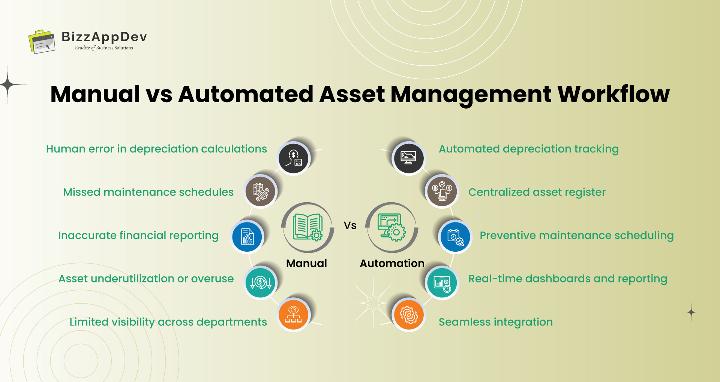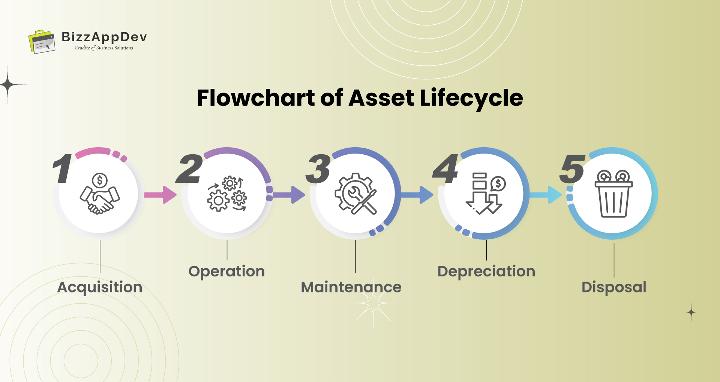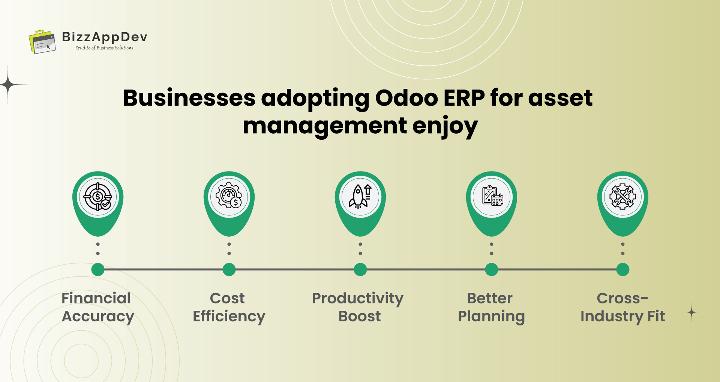Introduction – Why Asset Tracking Needs Automation Now
Managing assets like machinery, IT systems, vehicles, or store fixtures, has always been a complex and critical task for businesses. Using spreadsheets or outdated tools often leads to mistakes, missed maintenance, and inefficient financial reporting. These errors can slow operations, reduce profitability, and limit visibility across departments.
Today, business leaders are asking: “How can I track asset depreciation automatically?” or “What’s the best way to manage assets in real-time?”
Odoo Asset Management answers these questions. By automating asset tracking, maintenance scheduling, and depreciation calculations, Odoo ERP ensures operational efficiency and financial accuracy. Whether you are considering Odoo implementation, exploring Odoo customization, or integrating existing systems through Odoo integration, the Asset Module provides full lifecycle visibility and streamlined processes.

Why Automated Asset Management Matters
Spreadsheets and Manual Processes Are No Longer Enough
Traditional asset management methods, like spreadsheets or manual logs, work only for small-scale setups. As companies grow, these methods become unreliable:
- Human error in depreciation calculations
- Missed maintenance schedules
- Inaccurate financial reporting
- Asset underutilization or overuse
- Limited visibility across departments
Manual management slows decision-making and increases operational risk.
Automation Solves Key Challenges
Implementing an ERP-based asset management system like Odoo addresses these problems with:
- Automated depreciation tracking – accurate and compliant journal entries
- Centralized asset register – a single source of truth
- Preventive maintenance scheduling – proactive care reduces downtime
- Real-time dashboards and reporting – informed decisions instantly
- Seamless integration – connects Finance, Inventory, and Manufacturing
Odoo Asset Module – What It Does
Odoo’s Asset Module provides a unified platform to manage all assets, financial and operational, across their lifecycle. The module integrates with Odoo Accounting, Manufacturing, and Retail solutions, ensuring data consistency and automation across departments. Businesses can enhance these workflows further through Odoo customization to meet unique operational requirements.
Core Features of Odoo Asset Module
- Automated Depreciation: Define depreciation methods like straight-line or declining balance and let Odoo calculate automatically.
- Asset Categories: Organize assets by type for clear tracking.
- Maintenance Scheduling: Preventive and corrective maintenance planning.
- Full Lifecycle Management: Track every step from purchase to disposal.
- ERP Integration: Connect assets to Accounting, Inventory, and Operations for end-to-end control.
Tracking Depreciation in Odoo
How Odoo Automates Depreciation
- Create an asset record in Odoo.
- Assign it to a category (e.g., machinery, IT, vehicles).
- Set the depreciation method, duration, and frequency.
- Odoo automatically posts journal entries for each depreciation cycle.
Benefits
- Eliminates manual calculations
- Ensures compliance with accounting standards
- Improves financial accuracy
- Provides clear insights into asset value over time
Example: A manufacturing company purchases a $100,000 machine with a 10-year lifespan. Using straight-line depreciation in Odoo, the system automatically posts $10,000 depreciation annually, no manual entry required.
This automation can be further refined through Odoo customization to match company-specific accounting policies.
Maintenance That Keeps Your Assets Running
Effective maintenance ensures asset longevity and operational efficiency. Poor maintenance leads to costly downtime and higher repair expenses.
Maintenance Features in Odoo
- Preventive Maintenance Scheduling: Plan periodic checks to prevent failures.
- Corrective Maintenance Requests: Log and monitor repairs when issues arise.
- Maintenance Teams Dashboard: Assign, track, and report on technician tasks.
- Integration with Manufacturing: Ensure production assets are always operational.
Case Study: A retail chain uses Odoo Service Solution to manage POS systems, refrigeration units, and security devices across multiple locations. By scheduling preventive maintenance, equipment failures dropped by 30%.
Full Asset Lifecycle Management in Odoo
Odoo tracks assets from acquisition to retirement with automation at each stage.
Stage | How Odoo Helps |
Acquisition | Auto-create asset when purchase invoice is validated |
Operation | Track utilization, link to Manufacturing/Retail |
Maintenance | Schedule preventive maintenance to extend life |
Depreciation | Auto-accounting ensures accurate financial reporting |
Disposal | Record sale, disposal, or decommissioning correctly |
Why Lifecycle Management Matters
- Maximizes ROI from assets
- Prevents unnecessary purchases
- Aligns accounting with actual usage
- Supports informed capital investment decisions
Benefits of Automated Asset Tracking in ERP Systems
Businesses adopting Odoo ERP for asset management enjoy:
- Financial Accuracy: Automated journal entries reduce audit risks.
- Cost Efficiency: Optimized usage lowers operational costs.
- Productivity Boost: Preventive maintenance reduces downtime.
- Better Planning: Asset data supports forecasting and budgeting.
- Cross-Industry Fit: Works for manufacturing, retail, and service companies.
Best Practices for Asset Management in Odoo
To maximize benefits:
- Categorize Assets Properly: Clear categories make tracking easier.
- Automate Depreciation Rules: Standardized methods reduce errors.
- Leverage Maintenance Module: Follow preventive maintenance schedules.
- Regular Audits: Reconcile system records with physical assets.
- Integrate Modules: Ensure seamless connection with Accounting, Manufacturing, and Retail.
Tips for Different Industries
Manufacturing Businesses
- Link production equipment to the asset lifecycle
- Automate depreciation in line with production costs
- Integrate maintenance with production schedules
Retail Businesses
- Track POS terminals, store fixtures, and IT assets
- Schedule maintenance for refrigeration units and lighting systems
- Gain real-time visibility across branches
Service-Based Companies
- Manage IT infrastructure, vehicles, and office equipment
- Automate depreciation for leased or purchased assets
- Allocate asset costs to client projects
Example Workflow: Automated Asset Lifecycle in Odoo
- Purchase: A retail store buys a new POS system → Odoo logs the asset automatically.
- Usage: Assign the system to a specific store branch.
- Maintenance: Schedule preventive check every 6 months.
- Depreciation: Odoo posts monthly journal entries automatically.
- Disposal: After 5 years, asset is retired with proper accounting entries..
Conclusion – Why You Should Choose Automated Asset Management
Automated asset management in Odoo transforms how businesses track depreciation, schedule maintenance, and manage the full asset lifecycle. Whether for manufacturing companies, retail chains, or service providers, Odoo ERP ensures:
- Financial accuracy
- Operational efficiency
- Cost savings
- Better decision-making
Ready to optimize your asset management processes?
Let BizzAppDev handle the complexity so you can focus on growth. Contact us today for smarter, automated asset tracking.

